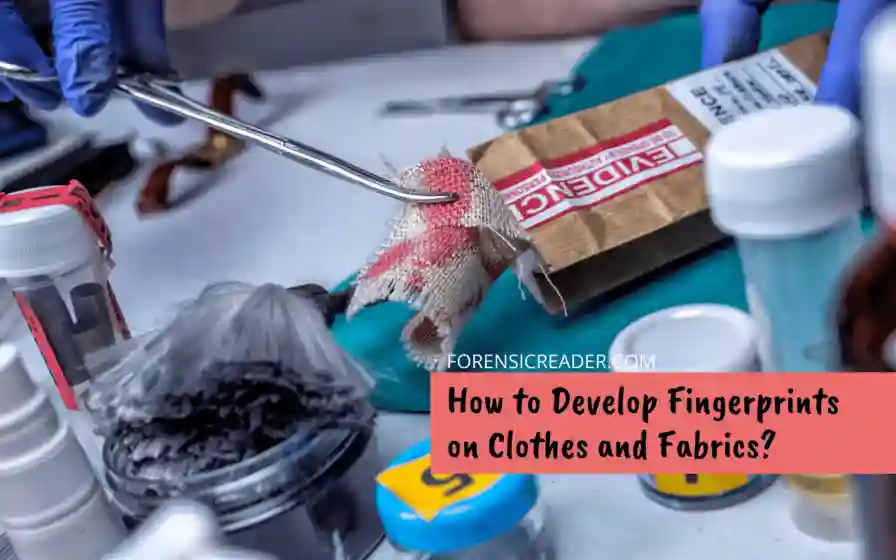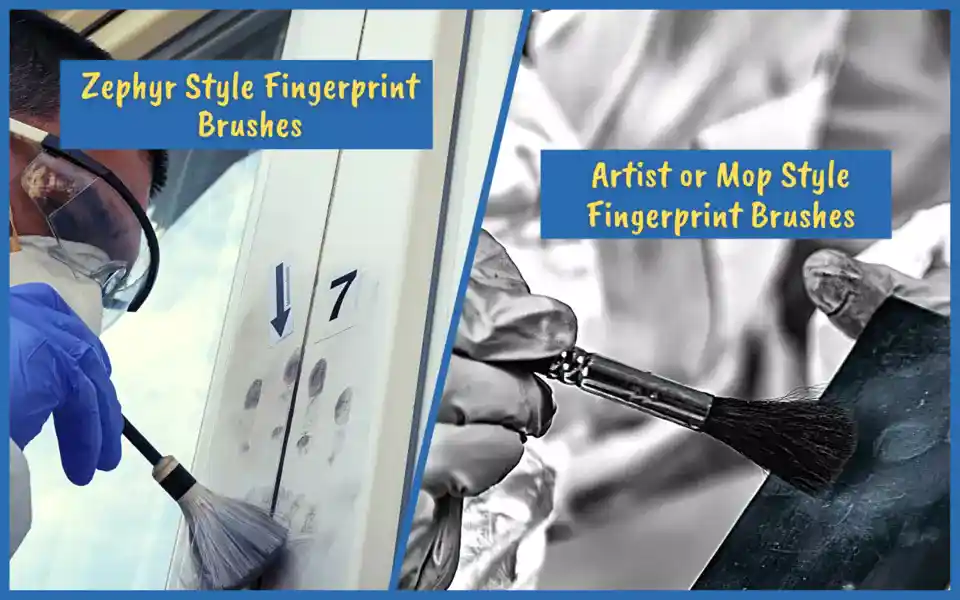Fingerprints on clothes are difficult to develop because of their complex fiber distribution, weave patterns, and lack of finger residue.
Some clothing is too coarse to retain fingerprints, while some retain them for a longer period of time because of the smoother and finely woven surface. If prints have enough finger residue to mark the clothing surface and depending upon various common types, they can be developed for up to 1 week to more than 1 year if remains undisturbed.
| Cloth Types | Time Fingerprint Stay on Clothes |
|---|---|
| Cotton | 1+ week |
| Cotton (soaked)* | 1+ years |
| Jeans (Denim cotton) | 2+ week |
| Wool | 1+ week |
| Leather | 3+ months (1+ year) |
| Nylon | 6+ months (1+ year) |
| Polyester | 3+ months (1+ year) |
| Silk | 1+ month |
| Hemp | 1+ week |
| linen | 1+ week |
Please Note: These are only the time frame the prints can be developed on not. It doesn’t imply whether the developed prints will be complete, partial or only empty marks (no ridge details).
Can Fingerprints Obtain From Clothes? And When?

Not all prints on clothes result in usable fingerprints. There are many factors such as macroscopic level of fabric, porosity, fiber diameter, irregular fiber profile, and weave type that affects whether a fingerprint can be found on the clothing surface or not. Among all, the most contributing factor is the fineness of weave patterns.
Case 1: Fingerprints of Porous Clothing
Clothing fabrics such as cotton and wool are porous and have irregular fiber diameters. This means, that if the finger marks are registered with high finger residue, they are soaked into fabric and can rest for a longer period of time. At the same time, irregularity in fiber usually results in incomplete or empty fingermarks.
Case 2: Fingerprints of Non-porous Clothing
Nylon and polyester usually have regular fiber diameters and very fine surfaces. This makes fingermarks easy to appear crisp and complete (because of regular fiber) but durability on the surface is less than on the soaked ones. Strictly talking about nylon, which is hygroscopic in nature and absorbs moisture from fingerprint residue, it can hold prints for a longer period of time.
Note: All types of fingermarks on clothes can easily be destroyed by wear and washing. However, soaked or absorbed fingermarks can resist wear to some extent.
Case 3: Fingerprints of Fine Weaved Clothing
Among all other factors, the finesses of weaving are the major factor that contributes to the finding of fingermarks on clothing surfaces. Loosely weaved— common in wool, cotton, and hemp— makes the surface too coarse to attain any finger ridge details. In these cases, no usable marks are found except empty fingermarks or grab marks.
On the other hand, as per research, shinier, tightly weaved non-porous textiles such as nylon can result in more usable and often complete fingermarks for at least 4 weeks which can even be stretched to at least 1 year (but empty fingermarks) if remain undisturbed.
Note: Empty fingermarks or grab marks impression indicates the sequence of events (for example palm print on front, indicate a plausible push from balcony) and highlight the region of fabric that should be targeted for DNA. They are usually helpful in cases involving assault.
Case 4: Dyes and Waterproofing
Clothes that were dyed and waterproofed usually assist the development and quality of ridge details. This improves the clothing surface hence a higher chance of getting crisp and complete fingerprints.
How to Develop Fingerprints on Clothes and Fabrics?

The development of fingerprints on clothes can be divided into three categories: (1) Latent prints on porous surfaces, (2) Latent prints on non-porous surfaces, and (3) blood fingerprints.
| Clothing Surfaces | Fingerprint Deposition | Developing Agents |
|---|---|---|
| Porous | Latent prints | Amino acid reagents: Ninhydrin and IND-Zn |
| Non-Porous | Latent prints | CA fuming and VMD |
| Porous/Non-porous | Blood prints | Amido Black |
| Non-Porous | Fresh prints | Powder dusting and chemical methods |
Note: Except for fresh prints on non-porous and finely woven clothing (where the powder dusting method can be used), the chemical and fuming method is employed.
1. Ninhydrin Reagents
Ninhydrin is one the most widely used chemical reagent that uses the amino acids in finger residue for fingerprint development on porous surfaces like fabrics. The resultant prints majorly form a Ruhemann’s purple reaction product which should be photographed under white light and a green-yellow filter.
One of the most used ninhydrin analogous was introduced by Morris and Goode in 1974 which is a non-flammable and non-polar ninhydrin formulation. It offers many advantages over regular ninhydrin solution for the detection of fingerprints such as higher sensitivity, low toxicity, non-flammability, and good non-ink running properties.
2. IND-ZN (1,2-indanedione)
One of the most sensitive alternatives of ninhydrin for the development of fingerprints on clothing and fabrics is Indanedione–zinc (IND-Zn).
On the reaction of IND-ZN with amino acids and proteins of fingermark residue, it results in pale pink coloration that is highly luminescent at room temperature. In the process, zinc salt is responsible for consistent excitation and emission spectra and acts as a Lewis acid catalyst.
The solution is better for the development of prints on very dark and multi-colored clothing. They observe and photograph the prints, and use an excitation band of 510-510nm while wearing orange goggles.
3. Cyanoacrylate (CA) Fuming
Cyanoacrylate fuming (SuperGlue) produces visible white fingerprints that can be easily visible to the naked eye. The fumes of CA adhere to finger residue resulting in white durable fingerprints.
Processing clothing with fingermarks uses a closed chamber where liquid cyanoacrylate solution is heated to vaporize which finally adheres to latent fingerprints. During adhesion, CA monomers form a durable polymer by the process of polymerization. The process can be accelerated by adding humidity to the chamber.
Apart from white CA fumed fingermarks, dye staining can also be employed for better contrast. However, research shows that it is not an effective method for recovering prints on fabrics due to the absorption of fluorescent dye on the entire surface of fabrics. (Source)
4. Vacuum Metal Deposition (VMD)
Vacuum metal deposition (VMD) is the most recommended and proven to be the best method for the development of latent fingerprints on clothes and fabrics. Like CA fuming, VMD also used a closed chamber but created a vacuum. Metal is vaporized that adheres to the substrate leaving behind latent prints. Thus producing negative fingermarks.

Main Qualities of VMD:
- Misner reported that VMD detects more latent prints than CA fuming.
- Fraser et al.’s (2014) study based on prints on four different fabrics (nylon, polyester, polycotton, and cotton) concluded that VMD produces around 5x more effective results than CA fuming.
- Older prints— more than 2 years— can be developed successfully with VMD that fails to develop by cyanoacrylate fuming.
- VMD produces greater details on smoother, nonporous fabrics while rougher porous fabric (cotton) only produced empty fingerprints.
- Knighting et al.’s (2013) studies stated that
- For dark fabrics such as satin and polyester, Ag VMD is a viable processing solution for visualizing fingermarks.
- For fingerprints on cotton and polycotton substrate, Au/Zn metal vapor should be used other than Ag metal vapors.
5. Amido Black
Amido Black reagent is a perfect solution for staining blood fingermarks on both porous and non-porous fabrics. However, as the resultant print color is dark blue-black, it is usually employed on light-colored clothing to achieve sufficient contrasts.
Comparative research by Mc Carthy and Grieve concluded that amido black is the best choice for treating fingermarks in blood. Warrick (2000) described a case where prints on cotton cloths were successfully enhanced using amido black which later leads to apprehending murder investigation.
6. Powder Dusting
Powder dusting is only used when the prints are fresh and fine-weaved clothing. Fresh prints on clothing such as polyester, nylon, and leather are one of the viable substrates for fingerprint development.
There are basically two types of dusting powders; one is magnetic and the other is non-magnetic. In any case, magnetic powder with a Magna brush should be employed for better dusting performance on the fine-weaved surface because of the very light strokes of the Magna brush.

Can You Lift Fingerprints From Clothes
Lifting fingerprints should not be done on porous fabrics such as cotton and wool. However, fingerprints on some clothing such as leather and polyester can be lifted easily with fingerprint lifters. For textured clothing, gel lifters or casting should be employed.
Why lifting fingerprints is not recommended for clothing surfaces?
For developing fingermarks on clothing, a series of chemical stains are used. Furthermore, clothes are woven, and lifting disrupts their fiber integration, which permanently alters the dimension and reduces the possibility of getting any prints from other developing methods. In addition, fibers from cloths get struck to lifting tapes or cast, which further hinders or even destroys ridge detailing.
To avoid lifting, forensic investigators develop fingermarks on fabrics in the laboratory rather than on the crime scene. And if clothing can’t be collected, investigators usually cut out the required area with fingerprints.
Is it Possible to Remove Fingerprints from Clothes?
A simple wash can easily remove fingerprints from clothes. In case, if the print is patent (made from a colored substrate such as blood, or paint) it depends on the nature of the coloring material. However, if prints are made at a very high temperature (that makes the surface shrink) on some clothing such as polyester or leather, they usually fixed the fingermarks and can’t be removed from washing.
Is it Possible to Extract DNA from Fingerprints on Clothes?

Most of the aged fingerprints on clothes are either partially ridged or empty prints (no ridges only outlines). But, these prints can further assist forensic examiners in obtaining highly individualistic DNA profiles.
Sweat residue in latent prints (invisible) contains a good quantity of cellular material, which serves as a source of DNA. Patent marks by blood further increase the chances of extracting DNA from suspected clothing.
However, while developing prints, examiners must have mind whether or not DNA is required because developing methods have a significant effect on whether DNA can be extracted or not.
References:
- Evaluation of the performance of IND/Zn and DFO on various porous substrates in Singapore context [ScienceDirect]
- Effects of latent fingerprint development reagents on subsequent forensic DNA typing: A review [ScienceDirect]
- Aspects of physicochemical methods for the detection of latent fingerprints [Link]
- Recent advances in latent print visualization techniques at the US Secret Service [Link]
- A comparison of VMD and CA fuming for visualisation of fingermarks and grab impressions on fabrics [PubMed]
- Aspects of Physiochemical Methods for the Detection of Latent Fingerprints [OJP.GOV]
Read More:
- Can You Get Fingerprints From Leather Purse, Wallet, or Gloves?
- Photographing Shoe & Tire Marks on Snow With Highlighting Materials
- 7 Importance of Casting In Forensic Crime Investigation [Explained]
- Forensic Rulers and Scales: Types, Characteristics, and Uses

FR Author Group at ForensicReader is a team of Forensic experts and scholars having B.Sc, M.Sc, or Doctorate( Ph.D.) degrees in Forensic Science. We published on topics on fingerprints, questioned documents, forensic medicine, toxicology, physical evidence, and related case studies. Know More.
